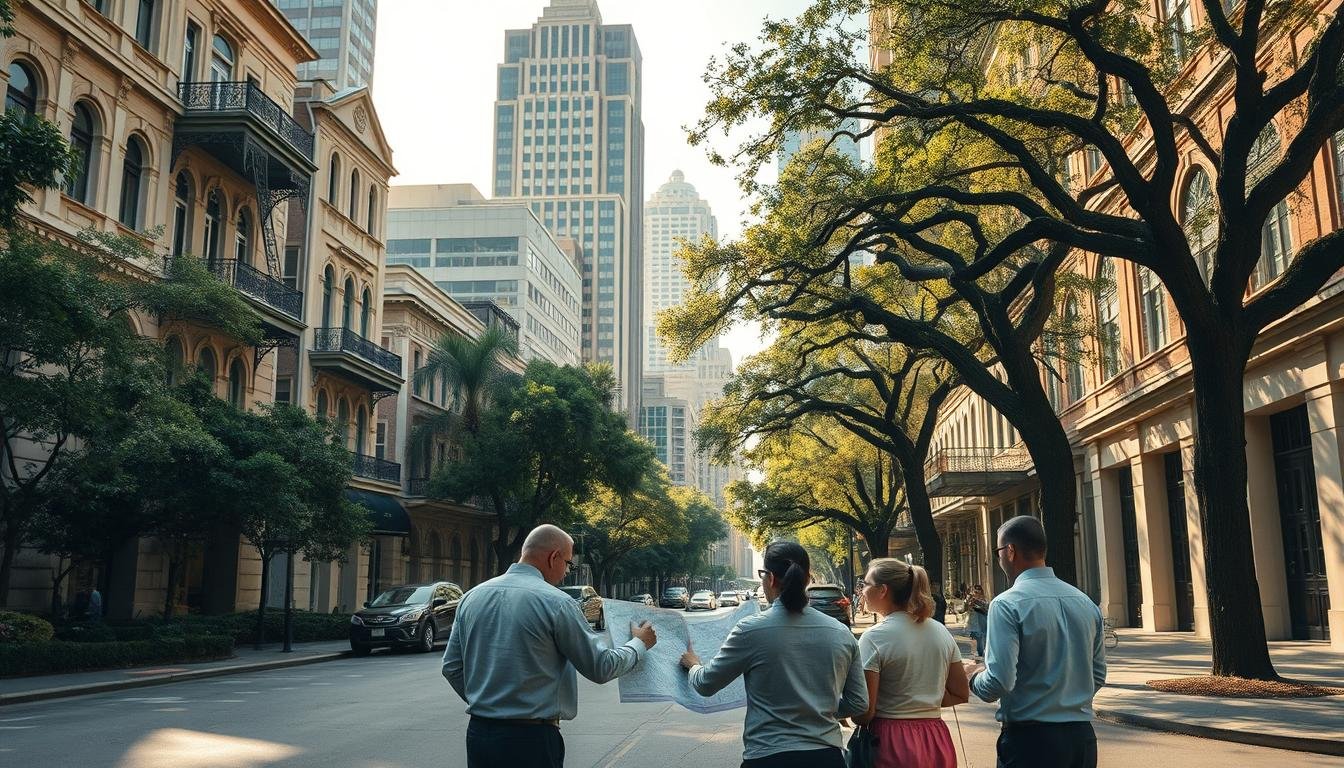As a local, I’m excited to share my knowledge of the Big Easy to help you plan an unforgettable trip in 2025. From the vibrant culture to the mouth-watering Creole cuisine, I’ll guide you through the essential planning tips to make the most of your visit.
Whether you’re a foodie, a history buff, or just looking for a unique experience, this article will provide you with the insider knowledge you need to navigate the city like a pro. With my local insights, you’ll be able to explore the best of New Orleans – from its iconic landmarks to its hidden gems.
Key Takeaways
- Discover the best times to visit popular attractions
- Learn about the unique cultural events and festivals
- Get insider tips on the best Creole cuisine
- Explore beyond the French Quarter
- Plan your itinerary with ease
Getting to New Orleans: Transportation Options
Getting to New Orleans is a breeze, with multiple transportation options at your fingertips. Whether you’re a seasoned traveler or just starting to plan your trip, understanding the various ways to reach this vibrant city is essential.
Best Airports for Travel
New Orleans is served by the Louis Armstrong New Orleans International Airport (MSY), a major hub that connects you to destinations worldwide. MSY is conveniently located just a few miles from the city center, making it easy to find your way to your final destination.
Airport Transportation Options include taxis, Uber, and Lyft, providing a convenient way to get to your hotel or other locations within the city. You can also consider public transportation or shuttle services for a more budget-friendly option.
Public Transportation Overview
The Regional Transit Authority (RTA) operates an extensive network of buses and streetcars, making it easy to get around without a car. The famous St. Charles Avenue streetcar is a great way to see the city’s historic neighborhoods while you travel.
| Transportation Mode | Route Coverage | Fare |
|---|---|---|
| Bus | Extensive network across the city | $3 single ride, $5 day pass |
| Streetcar | Historic routes like St. Charles Avenue | $3 single ride, $5 day pass |
Car Rentals: What You Need to Know
If you prefer to drive, several car rental companies have desks at the airport and throughout the city. Be aware that parking in popular areas can be challenging, and you may want to consider parking garages or lots.
Tips for Renting a Car include booking in advance to secure the best rates and checking the rental company’s policies on insurance and fuel.
By understanding your transportation options, you can plan your trip to New Orleans with confidence, ensuring a smooth and enjoyable journey.
Top Attractions You Can’t Miss
With its rich heritage and lively atmosphere, New Orleans is a treasure trove of iconic landmarks, unique experiences, and festive celebrations. As a local, I’ve had the pleasure of exploring this city from multiple angles, and I’m excited to share my insights with you.
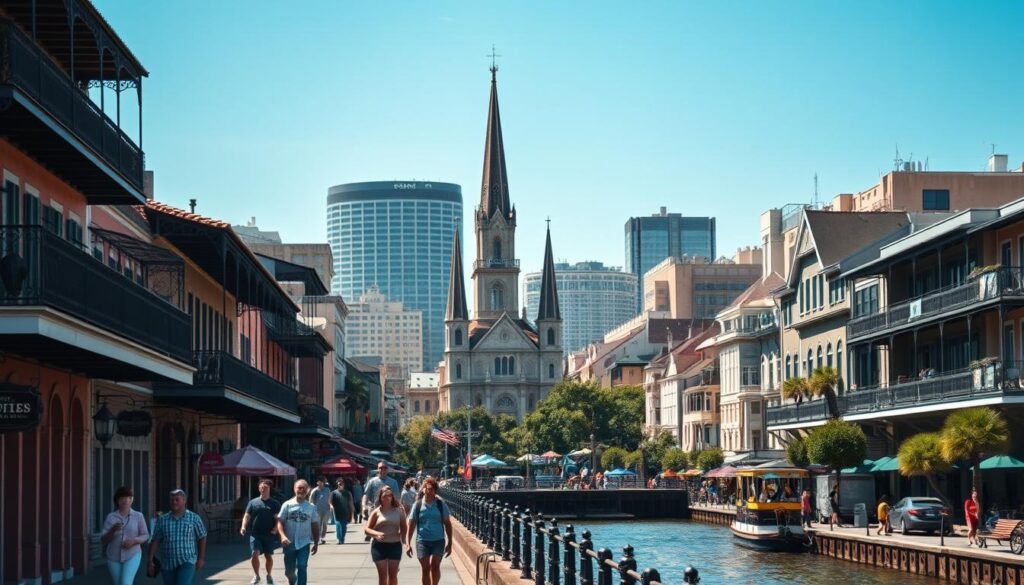
Iconic Landmarks to Visit
New Orleans is home to some of the most recognizable landmarks in the United States. One of the most iconic is Jackson Square, a historic park surrounded by stunning architecture, lively street performers, and some of the city’s best dining and shopping. Don’t miss the St. Louis Cathedral, a beautiful Catholic cathedral that’s been standing since 1794.
As you stroll through the French Quarter, you’ll come across numerous historic buildings and landmarks. Be sure to visit Bourbon Street, known for its vibrant nightlife, and Decatur Street, which offers a mix of shopping, dining, and entertainment.
Must-Try Experiences
New Orleans is a city that’s meant to be experienced, not just visited. One of the must-try experiences is taking a steamboat ride along the Mississippi River. It’s a great way to see the city from a different perspective while enjoying live jazz music and delicious Creole cuisine.
For music lovers, Preservation Hall is a must-visit. This intimate venue is dedicated to preserving traditional New Orleans jazz, and it’s an unforgettable experience to listen to some of the city’s best musicians in such a unique setting.
“New Orleans is a city that is always alive with music, always vibrant with culture… It’s a city that’s always on the move, always changing, but always staying true to its roots.” – Wynton Marsalis
Seasonal Events and Festivals
New Orleans is renowned for its festivals and events, which take place throughout the year. One of the most famous is Mardi Gras, a colorful and lively celebration that attracts visitors from all over the world. While Mardi Gras is a significant event, it’s not the only festival worth attending. Jazz Fest, held in April and May, is another highlight, featuring a mix of local and international music, delicious food, and cultural exhibitions.
For those interested in history and culture, the Voodoo Fest and French Quarter Festival are also worth exploring. Each event offers a unique glimpse into the city’s rich cultural heritage.
Where to Stay: Accommodations Guide
The right accommodations can make all the difference in your New Orleans adventure, offering a chance to immerse yourself in the local culture. With so many options available, from historic hotels to modern boutiques, choosing where to stay can be a bit overwhelming.
Best Neighborhoods for Tourists
New Orleans is known for its vibrant neighborhoods, each with its own unique character. The French Quarter is a top choice for many visitors, offering historic charm and easy access to many of the city’s most famous attractions. For a more modern vibe, the Warehouse District is a great option, with its sleek hotels and contemporary art scene.
Other neighborhoods worth considering include the Marigny, known for its bohemian flair and lively nightlife, and Central Business District, which offers a mix of modern amenities and historic significance.
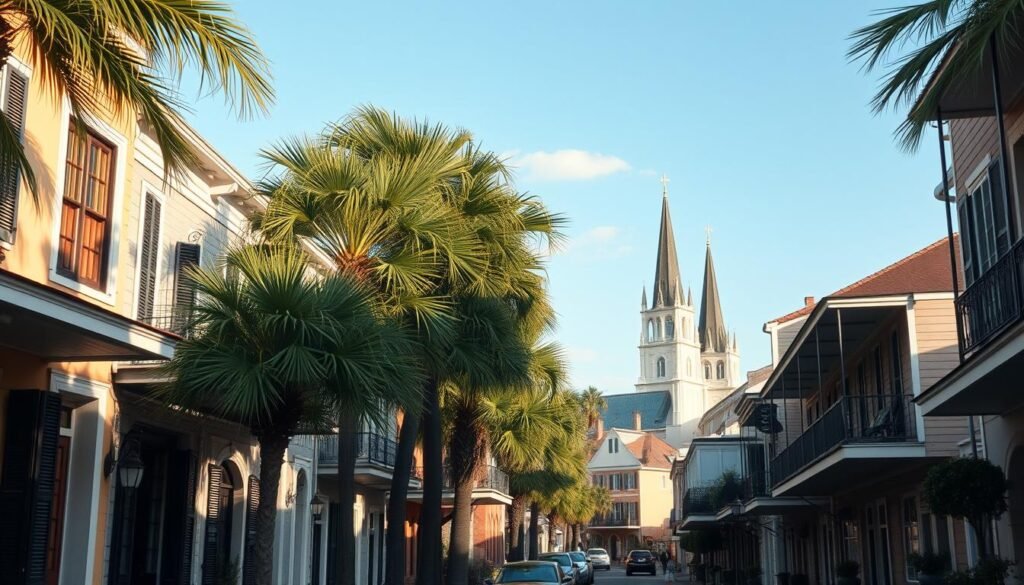
Luxury vs. Budget Hotels
New Orleans caters to all budgets when it comes to accommodations. For those looking to splurge, luxury hotels like the Ritz-Carlton offer top-notch service and amenities. On the other end of the spectrum, budget-friendly options like hostels and Airbnb apartments provide affordable comfort without sacrificing the city’s charm.
When deciding between luxury and budget, consider what’s most important to you. If you’re looking for a hassle-free, high-end experience, luxury might be the way to go. However, if you’re on a tighter budget or prefer a more local experience, budget options can be a great way to save money and still enjoy the city.
Unique Lodging Options
For a truly memorable stay, consider one of New Orleans’ unique lodging options. Bed and breakfasts offer a cozy, personalized experience, often with a rich history. Some hotels, like the Hotel Monteleone, are famous for their charm and character, making them a great choice for those who want to be in the heart of the action.
- Courtyards and boutique hotels for a more intimate atmosphere
- Historic mansions turned into hotels for a touch of elegance
- Vacation rentals for a home away from home experience
By choosing the right accommodations, you can enhance your New Orleans experience, making your trip even more enjoyable and memorable.
Savoring New Orleans Cuisine
New Orleans is renowned for its cuisine, a delectable fusion of different culinary traditions that beckon food lovers from around the world. The city’s culinary landscape is a reflection of its rich cultural heritage, shaped by French, Spanish, African, and American influences.
As you wander through the streets of New Orleans, the aroma of beignets and gumbo wafts through the air, teasing your taste buds and inviting you to explore the local cuisine. “New Orleans is a city where food is a way of life,” as the saying goes, and it’s not hard to see why. From casual eateries to fine dining establishments, the city offers a diverse range of culinary experiences.
Famous Dishes to Try
When visiting New Orleans, there are certain dishes you simply can’t miss. Jambalaya, a hearty rice dish loaded with sausage, chicken, and vegetables, is a staple of Creole cuisine. Another must-try is the Po’ Boy, a crispy French baguette filled with a variety of ingredients such as fried oysters or shrimp. And of course, no trip to New Orleans would be complete without sampling the city’s famous beignets at Cafe du Monde.
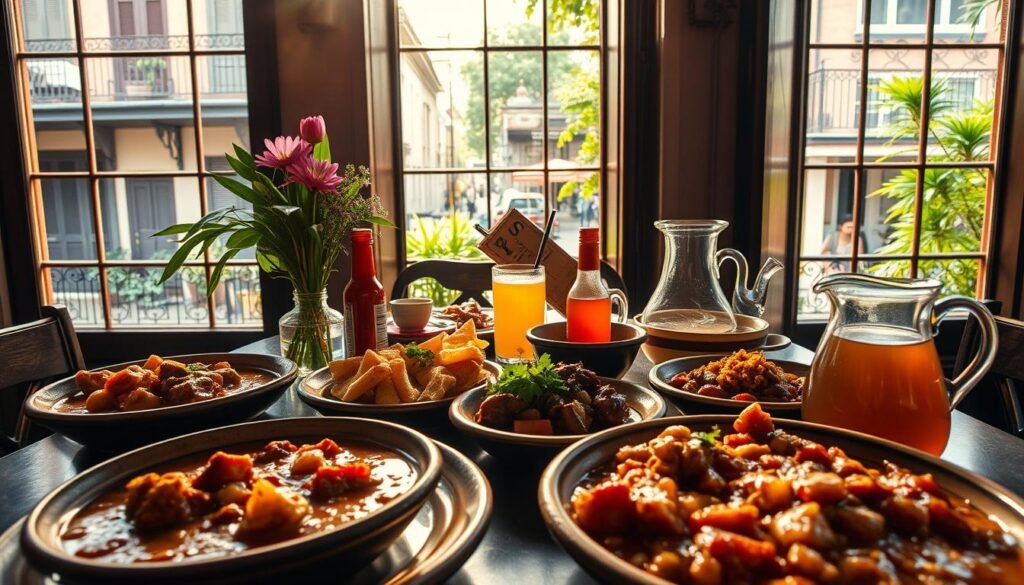
Recommended Restaurants
New Orleans is home to a wide range of excellent restaurants, each offering a unique take on the city’s cuisine. For a taste of traditional Creole cooking, head to Dooky Chase’s Restaurant, where you can enjoy gumbo z’herbes and other local specialties. For a more modern twist, visit Coop’s Place, known for its delicious fried chicken and red beans and rice.
“The food in New Orleans is a true reflection of the city’s cultural melting pot, with each dish telling a story of the city’s history and heritage.” –
Food Tours to Consider
One of the best ways to experience the full range of New Orleans cuisine is by taking a food tour. These guided tours take you to some of the city’s best eateries, where you can sample local specialties and learn about the history behind the dishes. Some popular food tours include the New Orleans Food Tour and the French Quarter Food Tour, both of which offer a delicious introduction to the city’s culinary scene.
Whether you’re a foodie or just looking to try something new, New Orleans cuisine has something to offer. With its rich flavors and cultural significance, it’s an integral part of the city’s identity and a key aspect of any visit to New Orleans.
Navigating the French Quarter
Navigating the French Quarter is an adventure that combines historic charm with modern excitement. As the heart of New Orleans, this iconic neighborhood is filled with narrow streets, historic landmarks, and a vibrant cultural scene.
The French Quarter is a place where you can easily spend days exploring its many charms. From the majestic St. Louis Cathedral to the lively street performers in Jackson Square, there’s always something to see or do.
Best Time to Visit
The best time to visit the French Quarter depends on your preferences. Spring and fall are ideal for pleasant weather and smaller crowds, making it perfect for strolling through the historic streets and enjoying the local cuisine.
- Spring: Enjoy the blooming flowers and mild temperatures.
- Fall: Experience the comfortable weather and exciting festivals like the New Orleans Film Festival.
- Summer: While it can be hot and humid, summer is a great time to enjoy the lively atmosphere and longer days.
- Winter: Visit during the holiday season for a magical atmosphere, or come for the Mardi Gras celebrations if you’re prepared for large crowds.
Local Customs and Etiquette
Understanding local customs can enhance your experience in the French Quarter. For instance, it’s considered polite to respect the privacy of residents and be mindful of noise levels, especially in the evenings.
- Be respectful of historic sites and buildings.
- Tip your servers and bartenders appropriately.
- Engage with local performers and vendors respectfully.
Safety Tips for Tourists
While the French Quarter is generally safe for tourists, it’s always wise to take certain precautions. Keep an eye on your belongings, especially in crowded areas, and stay aware of your surroundings.
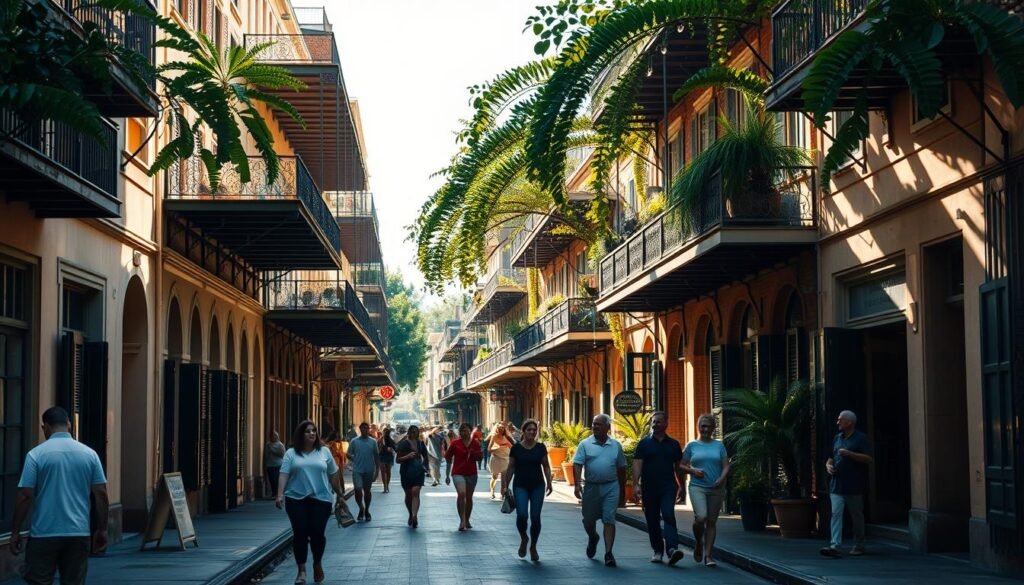
By being mindful of these tips and embracing the local culture, you can have a safe and enjoyable experience in the French Quarter. Whether you’re exploring the charming boutiques, enjoying beignet at Cafe du Monde, or simply soaking up the atmosphere, the French Quarter is sure to leave a lasting impression.
Exploring Beyond the City
Venture beyond the city limits, and you’ll uncover hidden gems that showcase the best of Louisiana’s natural beauty and rich history. As a local, I’m excited to share with you my favorite day trips and nearby attractions that are sure to enhance your New Orleans experience.
Day Trips from New Orleans
If you’re looking to escape the city for a day, there are plenty of exciting destinations within reach. One of my top recommendations is the Oak Alley Plantation, famous for its stunning Greek Revival architecture and picturesque oak-lined entrance. Another great option is the Laura Plantation, which offers a unique glimpse into the region’s history and culture.
For those interested in exploring the Mississippi River, consider a day trip to Vicksburg, Mississippi, a historic town with a rich Civil War heritage. You can visit the Vicksburg National Military Park and learn about the significant battles that took place there.
Nearby Natural Attractions
Nature lovers will find plenty to enjoy in the areas surrounding New Orleans. The Honey Island Swamp is a must-visit, offering a chance to see alligators, birds, and other wildlife in their natural habitat. Take a guided boat tour to explore the swamp’s unique ecosystem.
Another natural gem is the Fontainebleau State Park, located on the north shore of Lake Pontchartrain. Here, you can hike through scenic trails, go kayaking, or simply relax on the beach.
| Attraction | Location | Main Feature |
|---|---|---|
| Oak Alley Plantation | Vacherie, LA | Historic Greek Revival mansion |
| Honey Island Swamp | Slidell, LA | Guided boat tours through swamp |
| Fontainebleau State Park | Mandeville, LA | Hiking trails and kayaking |
Cultural Sites Worth Visiting
Beyond its natural beauty, the region around New Orleans is also home to a wealth of cultural attractions. The Avery Island, for example, is not only known for its Tabasco sauce production but also features the Jungle Gardens, a unique wildlife sanctuary.
For a deeper dive into the region’s history and culture, visit the Rural Life Museum in Baton Rouge, which showcases the state’s rural heritage through exhibits and living history demonstrations.
By exploring these day trips and nearby attractions, you’ll gain a richer understanding of the area’s diverse culture and natural beauty, making your New Orleans trip even more memorable.
Essential Packing Tips for Your Trip
When preparing for your trip to New Orleans, it’s essential to consider the city’s unique climate and cultural scene. The city’s subtropical climate means you’ll want to pack accordingly, but it’s not just about the weather – the city’s vibrant energy demands a certain kind of preparation too.
Weather Considerations
New Orleans is known for its hot and humid summers, so lightweight, breathable clothing is a must. However, the weather can be unpredictable, with occasional cold fronts in the spring and fall, and the potential for hurricanes in late summer and early fall. It’s a good idea to check the forecast before your trip to ensure you’re prepared for any conditions.
What to Wear and Bring
Comfortable shoes are a must, as you’ll likely be doing a lot of walking. Consider packing:
- Lightweight, breathable clothing
- Comfortable walking shoes
- Sunscreen and a hat for sun protection
- A light jacket or sweater for cooler evenings
- A camera to capture the city’s unique energy
Here’s a quick reference table to help you pack:
| Item | Why You Need It |
|---|---|
| Lightweight Clothing | For comfort in the city’s subtropical climate |
| Comfortable Shoes | For walking around the city’s many attractions |
| Sunscreen | To protect yourself from the sun |
| Camera | To capture the city’s vibrant culture and scenery |
Items to Leave Behind
While it’s tempting to pack everything, there are a few items you can leave behind to make your trip more enjoyable. Consider leaving:
- Valuables that you don’t need
- Uncomfortable shoes
- Too much cash – credit cards are widely accepted
By packing smart and leaving behind items you don’t need, you’ll be free to enjoy all that New Orleans has to offer.
Staying Connected in New Orleans
As you immerse yourself in the jazz and jambalaya of New Orleans, staying connected is easier than ever. Whether you’re navigating the French Quarter or exploring beyond, having reliable mobile and Wi-Fi access can make your travel experience even more enjoyable.
Mobile and Wi-Fi Access
New Orleans is well-equipped with various connectivity options. You’ll find that many cafes, restaurants, and public spaces offer free Wi-Fi. For instance, most areas of the French Quarter have reliable internet access, making it easy to stay in touch with family and friends or work on the go.
Key locations with Wi-Fi include:
- Major hotels and resorts
- Coffee shops like Café du Monde
- Public libraries
- Some streetcars and bus stations
Local SIM Cards vs. Roaming Plans
When it comes to mobile access, you have two primary options: purchasing a local SIM card or using your existing roaming plan. Each has its pros and cons.
Local SIM Cards: These can be more cost-effective, especially if you’re staying for an extended period. You can purchase SIM cards at various convenience stores and mobile shops throughout the city.
Roaming Plans: If you’re only visiting for a short time, your existing roaming plan might be sufficient. However, be aware that roaming charges can add up quickly.
| Feature | Local SIM Card | Roaming Plan |
|---|---|---|
| Cost | Generally cheaper for long stays | Can be expensive |
| Coverage | Good local coverage | Depends on your provider |
| Convenience | Requires SIM card purchase | No need to change SIM |
Useful Apps for Travelers
To make the most of your New Orleans experience, consider downloading some useful apps:
- Navigation: Google Maps or Citymapper for getting around the city.
- Language: Google Translate can help with any language barriers.
- Local Insights: Apps like TripAdvisor or Yelp can provide valuable recommendations.
By staying connected, you can enhance your New Orleans adventure, from finding the best beignet spots to navigating the city’s vibrant neighborhoods.
Cultural Sensitivity and Etiquette
As you explore the vibrant city of New Orleans, being mindful of local customs and traditions will enhance your experience. I’ve lived here all my life, and I’m happy to share some insights on how to be a respectful visitor.
Respecting Local Traditions
New Orleans is known for its rich cultural heritage, from jazz to cuisine. When visiting historic sites like St. Louis Cemetery No. 1, be sure to follow the rules and respect the city’s ancestors. Planning your visit during less busy times can also make for a more enjoyable experience.
Dos and Don’ts
Some simple new orleans travel tips: be respectful of street performers, tip your musicians, and don’t take pictures inside churches. When walking through the French Quarter, stay on the banquettes and be mindful of your surroundings. Local advice suggests that exploring on foot is the best way to discover the city’s hidden gems.
Engaging with the Community
New Orleans is a city that thrives on community. Attend local events, visit neighborhood markets, and strike up conversations with locals. By doing so, you’ll not only gain a deeper understanding of the city’s culture but also contribute to the local economy. With a little planning and an open mind, you’ll have a truly authentic New Orleans experience.
FAQ
What’s the best time to visit New Orleans?
The best time to visit New Orleans is from February to May, when the weather is mild and the city hosts various festivals, including Mardi Gras and Jazz Fest. Avoid visiting during the peak summer months if you’re sensitive to heat and humidity.
How do I get around the city without a car?
New Orleans has a comprehensive public transportation system, including buses and streetcars. You can also use ride-sharing services like Uber and Lyft, or take a taxi. The city is also pedestrian-friendly, making it easy to explore on foot.
What’s the most iconic New Orleans cuisine I shouldn’t miss?
You can’t go wrong with trying beignets at Cafe du Monde, but other must-try dishes include gumbo, jambalaya, and po’ boys. Be sure to visit some of the city’s renowned restaurants, like Dooky Chase’s Restaurant and Coop’s Place.
Are there any specific customs or etiquette I should be aware of in the French Quarter?
Yes, be respectful of the city’s historic architecture and cultural heritage. Avoid taking pictures inside churches or other sensitive areas, and be mindful of street performers and vendors. Also, keep in mind that some areas can be quite crowded and noisy, so be prepared for that.
Can I visit New Orleans on a budget?
Absolutely! New Orleans offers a range of accommodation options, from budget-friendly hotels to luxury resorts. You can also save money by eating at local eateries, visiting during the off-season, and taking advantage of free or low-cost activities like visiting the National WWII Museum or exploring the French Quarter.
What’s the best way to experience the city’s vibrant music scene?
New Orleans is known for its jazz, so be sure to visit Preservation Hall, the Spotted Cat Music Club, or the Howlin’ Wolf music venue. You can also take a music tour or visit during one of the city’s many music festivals, like Jazz Fest or the French Quarter Festival.
Are there any day trip options from New Orleans?
Yes, there are plenty of exciting day trip options from New Orleans, including visiting the Oak Alley Plantation, exploring the Honey Island Swamp, or taking a trip to the historic town of Covington. You can also visit the nearby city of Baton Rouge, the capital of Louisiana.
How can I stay connected during my trip to New Orleans?
You can stay connected with mobile and Wi-Fi access, and consider purchasing a local SIM card or portable Wi-Fi hotspot. Many cafes and restaurants also offer free Wi-Fi, making it easy to stay online. Download useful travel apps, like Google Maps or the New Orleans Tourism app, to help navigate the city.
